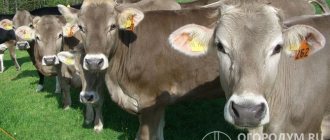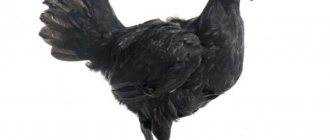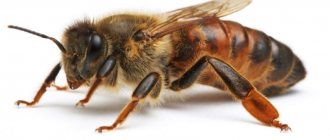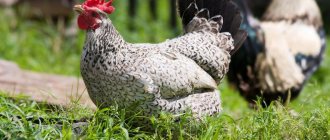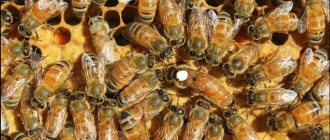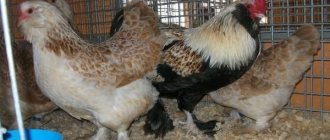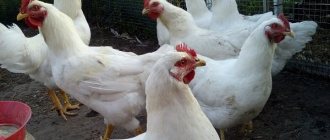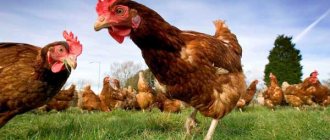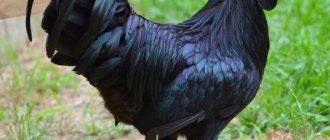Poultry farming » Chickens
0
4503
Article rating
Kira Stoletova
The Arbor Acres broiler is one of the newest poultry breeds. Despite this, almost every farmer knows Arbor broilers. The breed has rapidly gained popularity all over the world and can be found in almost every poultry farm. British, American and French breeders worked on the creation of such a breed.
Characteristics of the Arbor Acres broiler
Cross history
When breeding the breed, breeders set out to achieve maximum weight gain in the livestock in the shortest possible time. Through the joint efforts of scientists from the USA, France and Great Britain, it was possible to obtain not only a large, but also an unpretentious and early-ripening hybrid, which reaches 30-40% of its maximum weight by the end of the first month of life. Like other meat crosses, Arbor Acres was created on the basis of several parent lines.
Thanks to the high quality of meat and rapid growth, the new breed can take a leading position in the agricultural market. In terms of external and technical characteristics, the arbors are not inferior to the Cobb-500 and Ross-308 broilers, which are traditionally chosen for breeding.
What is a meat hybrid
In fact, broilers are not a breed at all. This term is used in livestock farming to refer to poultry (chickens, ducks, geese) and rabbits. It means a meat-oriented hybrid. A hybrid is created by crossing different breeds. To breed broiler crosses, both meat and egg parent forms are used.
At first, only Plymouthrock (maternal line) and Cornish (paternal line) were used. This practice was common from the 193s to the 1960s. Today scientists are using other breeds of chickens:
- Jersey giant;
- gate;
- Cornish fighting;
- new hampshire
The hybrid receives the best qualities from its ancestors. Chickens are actively developing and, as a rule, after 50 days of life they are ready for slaughter. There is only one big “BUT” - crosses are not able to pass on their outstanding characteristics by inheritance. They are not at all infertile, as many people mistakenly believe. It is possible to obtain offspring, but they will have unpredictable characteristics. Sometimes chickens are able to repeat record results, but most likely the time will be wasted.
The longer poultry farming develops, the better the result of selection. Modern versions of meat chickens not only grow quickly and gain weight, but also have strong immunity. After all, the infection destroys the entire livestock in a matter of days - and for a private owner this is a real tragedy. Therefore, there are no trifles in matters of animal health.
A typical meat chicken has a strong build, strong legs, and small wings. The color of the plumage is white, the skin is most often yellow or with a yellowish tint. Grown-up individuals have well-developed breasts, they do not have agility and egg production, but they quickly gain weight.
Distinctive features
the Arbor Acres
meat have several characteristic features:
- large body with a wide back and chest;
- the body is angular, with strong bones;
- chickens have a voluminous rounded chest, roosters have large fleshy thighs and legs;
- a small head with a pinkish leaf-like crest, orange eyes and pink-red earrings;
- the neck is short, slightly curved;
- powerful, short and widely spaced paws of yellow color.
The plumage of arbors is not too thick, but dense. The characteristic color is white, without pronounced color accents. An important advantage of the cross is the natural yellowish tint of the skin, which gives the carcasses a marketable appearance.
The maximum weight of a male broiler is 5-6 kg, and a female 4-5 kg.
When analyzing the characteristics of Arbor Acres and the descriptions of these birds, the advantages of the breed become obvious. Large thighs, legs and breasts ensure a high yield of meat from the carcass (up to 72%), and developed muscles ensure a reduced fat content of the product.
How were they brought out?
Broilers are a hybrid variety bred by crossing several breed lines. To obtain hybrids, meat and meat-egg directions are used. Broilers are not a breed at all, but a popular name for meat chickens. Birds are specially bred for their meat. The word "broiler" is translated as "fry", which means that chicken meat is suitable for frying over a fire.
Initially, in order to obtain hybrids, they took breeds of birds such as Cornish and White Plymouthrock. The Cornish were attracted as fathers, and the Plymouthrocks as hens. To breed new broiler chickens, breeds such as New Hampshire, Brahma, Betta Cornish, Langshan, and Jersey Black Giant are used.
The broilers obtained from crossing are distinguished by their developed meat forms, high weight, large breast and excellent taste characteristics of the meat. Broiler chickens grow quickly and gain weight. They eat the same amount as ordinary chickens. It takes 2-3 kilograms of dry food to raise a broiler for up to 2 months (before slaughter). At two months of age they weigh 2 kilograms or more; the weight of an adult chicken is almost 5 kilograms.
When producing chickens, special requirements are placed on the commercial quality of carcasses. The bird should not have dark feathers or dark skin. Parent breeds must have dominant, snow-white plumage and yellowish (pale) skin.
As a result of crossing, chickens with light (sometimes red) feathers are obtained. Hybrids have a large body, small head, and muscular legs. Birds have poorly developed combs and barbs. Chickens are sedentary and have a calm character.
Broilers are characterized by active gain of live weight. At 6-9 weeks of life, chickens are ready for slaughter. At this age, their weight is 2.45-3 kilograms. Broilers lay eggs well and produce about 120-180 eggs per year. However, all the positive qualities of their parents are not passed on to their offspring. Broiler chickens are bred only through selective crossbreeding.
Incubation
brooding instinct in Arbor Acres chickens . Young broilers are purchased at one day old or hatched from eggs using an incubator.
Breeding a new generation at home is ineffective. The resulting chickens do not always inherit the genetic characteristics of their parents, so the stock quickly degenerates. To get large and strong representatives of the cross, you need to regularly purchase eggs or chickens. This is one of the main disadvantages of the cross.
Diseases
Representatives of the cross are not distinguished by good health. Birds are susceptible to infections characteristic of birds; in the presence of drafts they quickly catch colds; in conditions of high humidity they experience severe discomfort and malaise.
- Parasites
- Infectious
- Other
Chicken mite
How to treat a chicken coop and how to treat a bird. Description of drugs and methods of control
Read
Coccidiosis
Thirst, loss of appetite, swelling, bloody droppings, anemia, weakness, poor coordination
Read
Ascariasis
Loss of appetite, liquid droppings, pale mucous membranes of the comb, limbs, ruffled plumage, lethargy, vomiting
Read
Amidostomiasis
Symptoms of the acute form: apathy, general weakness, decreased or lack of appetite, breathing problems, unsteady gait, retarded growth and development
Read
Prostagonymosis
Decreased mobility, loss of appetite, unsteady gait, bloating, fever, impaired egg laying, exhaustion
Read
Knemidocoptic mange (“lime foot”)
Acute symptoms: light gray bumps appear on the legs, the bird limps and stands on one leg, the cloaca and joints become inflamed, the beak is deformed
Read
Heteracidosis
Symptoms: indigestion, diarrhea, loss of appetite, lethargy, decreased egg production, retarded growth and development
Read
Trichomoniasis
Symptoms of the acute form: fever, depression and loss of appetite, diarrhea with gas bubbles and a putrid odor, enlarged goiter, difficulty breathing and swallowing
Read
Pullorosis (typhoid fever, salmonellosis)
Weakness, lack of coordination, drooping eyelids, difficulty breathing, lack of appetite, indigestion
Read
Colibacillosis
Lack of appetite, thirst, sudden increase in temperature, pale scallops, diarrhea
Read
Pasteurellosis
Fever, foamy mucus, change in stool color, refusal to feed, thirst, lethargy, wheezing, heavy breathing
Read
Marek's disease
Paralysis of the limbs, difficulty breathing, severe exhaustion and loss of strength, refusal of food and water, pallor of the scallop
Read
Gumboro disease
Diarrhea, loss of appetite, trembling legs and head, sudden death
Read
Laryngotracheitis
Weakness, swelling of the neck, difficulty breathing, cough, wheezing, blood clots in the mucus released when coughing, lack of appetite, indigestion
Read
Bird flu
Refusal to eat, anorexia, diarrhea, purulent discharge, hoarse breathing, greenish-brown droppings, seizures, darkening of the ridge
Read
Newcastle disease
Decreased appetite, fever, respiratory distress, immobility, conjunctivitis, bloody diarrhea
Read
Apteriosis
Complete or partial absence of plumage, loss of tail feathers, broken embryonic fuzz in young animals, delayed growth of plumage, pecking
Read
Pterophagy
Plucking and eating feathers. What is the reason, why does it require urgent intervention and how to prevent the disease?
Read
Yolk peritonitis
Symptoms of the acute form: loss of appetite, gray-green color of feces, sudden drop in egg production, calcareous deposits on the shell, bluish tint and baldness of the abdominal skin
Read
Cloacite
Symptoms: depressed state, decreased appetite, weight loss, increased need for water, loss of plumage, inflammation and bulging of the cloaca, the presence of ulcers on the mucous membrane, decreased egg production
Read
Features of broiler chickens
Arbor Acres chickens have good survival rate and rapid growth. The low percentage of losses among young animals is no less important advantage of the cross than early maturity.
With proper feeding, by the 30-35th day of life, arbors gain up to 2 kg. They reach adult weight at 2.5-3 months.
The basis of the diet of young animals is special compound feed. Unlike ordinary chickens, they cannot tolerate boiled eggs, many cereals and vegetables. Compound feed is selected strictly depending on the age of the broiler.
The main menu is enriched with liquid vitamin supplements, mineral powders and weak disinfecting solutions. For drinking, chicks and adult broilers should use clean water with a low content of mineral salts.
Positive aspects of the breed
Arbor is considered one of the most highly productive breeds among other species. If a broiler is fed high-quality feed, it will quickly gain weight. A one-month-old chick with normal feeding can weigh 2 kg.
After one week, young animals can gain 1 kg. Adult representatives of the species can weigh more than 6 kg.
The meat of representatives of this variety has incredible taste characteristics: it is soft, nourishing, tasty, and dietary.
The second positive feature is the unpretentiousness of the young: chickens can eat anything. This ability should not be abused: the quality of the meat will depend on what the winged birds eat.
As mentioned earlier, meat of this type is dietary, which means it contains a small percentage of calories.
In addition, most doctors say that meat of this type can be considered hypoallergenic.
All characteristics of the Arbor cross broiler have only positive reviews, since the pets are calm, unpretentious, can eat absolutely everything and at the same time gain weight, and have good egg production. Meat of this type is perfect for small children, teenagers, the elderly, people with allergies, and those on a diet. The reason for this is the presence of many useful substances in the product.
After slaughter, the meat yield is more than 72%.
But there are also disadvantages - heat-lovingness and sensitivity to diseases can lead to serious losses, both among young animals and in the adult family.
Diet for adult Arbor Acres chickens
The diet of adult chickens, like other broiler breeds, consists mainly of grains with the addition of meal and feed. Some owners, wanting to get a guaranteed result, make compound feed the basis of the menu. This approach slightly increases the cost of meat, but provides broilers with all the necessary nutrients.
As a supplement to the diet, use:
- mineral supplements;
- oil and water solutions of vitamins;
- protein-vitamin premixes;
- vegetables;
- green mass.
The share of vegetables should be no more than 20% of the total food. Additives are added to wet mash mixtures. Fresh vegetables can cause digestive problems, so they must be cooked.
Growing rules
Here are a few rules on how to raise healthy and strong broilers:
- Carefully create a diet: it should contain all vitamins, positive substances, calcium, magnesium. The easiest way is to buy chicken feed: it will contain everything the bird needs.
- The chicken coop should always be warm, especially in winter.
- Ideal cleanliness and sterility in the place of detention.
If you follow all the rules for feeding and care, you can achieve a 100% guarantee of obtaining tasty and soft meat. The Arbor species is considered a destroyer of meat stereotypes because this meat is always soft.
Maintenance and care
The main conditions for maintaining the health of chickens are cleanliness, warmth and comfortable conditions in the poultry house. Arbors are sensitive to sudden cold snaps, drafts and high humidity, so the owner will have to monitor the readings of the thermometer and hygrometer.
In the warm season, the temperature in the chicken coop should not fall below 20...240C, and in the cold season - 14...160C. Broilers can be kept either on perches (in a poultry house) or in cages. The chosen method affects the recommended temperature and humidity indicators:
- when birds live in cages - not lower than 240C, not more than 60% humidity;
- in the poultry house - no less than 200C, no more than 70% humidity.
When keeping outdoors and regular walking, it is important to protect the arbor area from other inhabitants of the yard. Some poultry farmers note that walking slows down the rate of weight gain in chickens. During the period of active growth, it is recommended to keep broilers in cages.
However, for older arbors, the presence of a walking yard is recommended, since regular activity makes the meat more tasty, and fresh grass serves as an additional source of nutrition and vitamins.
To preserve the livestock, it is important to keep the litter clean and treat the chicken coop with disinfecting solutions. All disinfectants must be intended for poultry houses and agricultural premises. The poultry house is treated at least once a month.
A mixture of hay, straw or sawdust with wood shavings is used as bedding. Depending on the conditions, floor insulation may be required.
Incubation
The cross breeds well in the incubator. The procedure for selecting eggs is standard; before laying, disinfection with special solutions is mandatory. This guarantees high survival rate of chicks and strong immunity.
Table of temperature and humidity modes
| Period |
